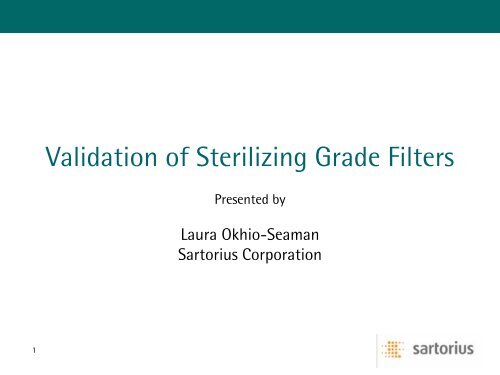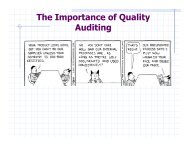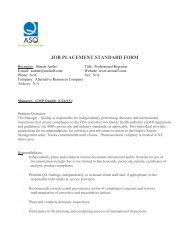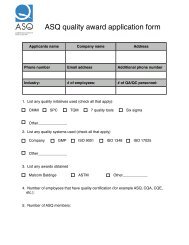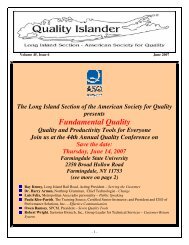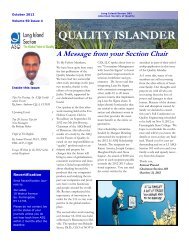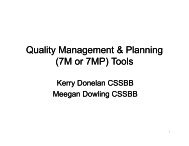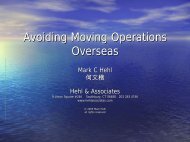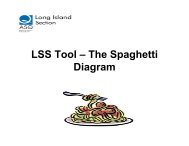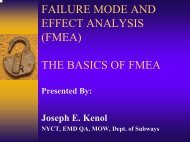Validation of Sterilizing Grade Filters - ASQ Long Island Section
Validation of Sterilizing Grade Filters - ASQ Long Island Section
Validation of Sterilizing Grade Filters - ASQ Long Island Section
You also want an ePaper? Increase the reach of your titles
YUMPU automatically turns print PDFs into web optimized ePapers that Google loves.
<strong>Validation</strong> <strong>of</strong> <strong>Sterilizing</strong> <strong>Grade</strong> <strong>Filters</strong>Presented byLaura Okhio-SeamanSartorius Corporation1
<strong>Sterilizing</strong> <strong>Grade</strong> <strong>Filters</strong>The definition <strong>of</strong> a sterilizing grade filter is one that will produce a sterileeffluent after being challenged by microorganisms at a challenge level <strong>of</strong>greater than or equal to 1x10 7 /cm 2 <strong>of</strong> effective filtration area.2
Filter Qualification Tests‣ Physical Tests– Flow rates, differentialpressure, throughput– Sterilizability (SIP, Auto)– Integrity tests (bubble point,diffusive flow)‣ Biological Tests– Viability– Bacterial challenge test– Bioburden studies‣ Compendial Tests (USP,EP)– Particle release– Oxidizable substances–Biosafety– Endotoxin‣ Other Tests– Non-volatile residue– Quantitative and qualitativeextractables analyses inwater and ethanol– Leachables testing3
<strong>Validation</strong> <strong>of</strong> <strong>Sterilizing</strong> <strong>Grade</strong> <strong>Filters</strong>‣ Demonstrates the filter retains microorganisms toproduce a sterile filtrate‣ Ensures the filter does not alter the product in anobjectionable way‣ Ensures the product does not adversely affect thefilter – compatibility‣ Ensures the physical parameters <strong>of</strong> the process donot adversely affect the filter or the product4
Filter Qualification TestsViability5
Filter Qualification TestsBrevundimonas diminuta (ATCC 19146)Until the late 1960’s, 0.45 μm-rated membraneswere considered “sterilizing grade” filters, and wereused successfully in the sterilizing filtration <strong>of</strong> parenterals.In the mid-1960’s Dr. Frances Bowman observed a 0.45 μm“sterile-filtered” culture medium to be contaminated with amicro-organism, subsequently shown to penetrate 0.45 μm-ratedmembranes repeatedly in small numbers.6
Viability Test‣ Evaluation <strong>of</strong> potential bactericidal effects <strong>of</strong> the productsolution‣ Viability verified by direct inoculation into product andmaking serial dilutions‣ Test exposure time should equal or exceed actual processfiltration time‣ If less than a one-log reduction (LRV) is observed, productconsidered non-bactericidal‣ Greater than one-log reduction indicates product isbactericidal and alternatives should be considered7
Viability Test Examples8
Filter Qualification TestsBacterial Challenge9
Bacterial Challenge TestFilter Qualification by SupplierChallengeDocumentBacteria/Water SuspensionStand. Cond.Process-related Filter <strong>Validation</strong> by User/External LabChallengeDocumentProcess Cond.Bacteria/Product Suspension10
Bacterial Challenge TestFactors potentially affecting microbialretention include‣ Filter Construction (structure, membranepolymer, pore size distribution)‣ Formulation components‣ Formulation properties (pH, viscosity)‣ Process conditions (time, temperature, pressuredifferential, flow-rate)11
Bacterial Challenge TestMicrobial retention studies on filter devices:‣ Brevundimonas diminuta (ATCC 19146) has been provento penetrate a 0.45 μm rated filter‣ Spiking <strong>of</strong> the drug product with Brevundimonasdiminuta according to ASTM 838-05‣ Challenge level > 10 7 CFUs / cm 2 filtration area.‣ <strong>Validation</strong> Testing should simulate worst-case processconditions e.g., pressure differential, flow-rate, time,temperature12
Bacterial Challenge Test‣ Challenge suspension should be mono-dispersed to provide‘worst-case’ challenge‣ Optical microscopy is used to detect aggregation andclumping <strong>of</strong> bacteria‣ Ultrasonic treatment reduces aggregation‣ Penetration <strong>of</strong> 0.45 μm rated membranes is indicative <strong>of</strong>single-cell conditions and this membrane is used as apositive control13
Bacterial Challenge TestMicroscopic investigationCriteria: single cells, motile cells0.6-1.0 μm0.3 -0.4 μmworst-case14
Bacterial Challenge Test‣ ASTM 838-05 (2005) uses B. diminuta as the standardchallenge organism‣ 2004 Aseptic Processing Guidance suggests the use <strong>of</strong> nativebioburden isolate when appropriate15
Bacterial Challenge TestMicrobiological challenge tests using one lot <strong>of</strong> low Bubble Point(close to manufacturer’s minimum specification) membranes shouldbe used. *Example:Minimum Bubble Point Value:Release criteria <strong>of</strong> filter vendor:Low BP Range:46 psi50 psi46 – 50.6 psi* At or near filter manufacturers minimum integrity test value (10%),1999 PDA / FDA Joint conference, PDA Newsletter December 199916
Filter Medium vs. Device‣ The purpose <strong>of</strong> the test is to validate the retention efficacy<strong>of</strong> a particular membrane material. A small 47mmmembrane disc can be used‣ To more closely simulate process conditions and todetermine the integrity <strong>of</strong> process filters, a small area 150or 300 cm 2 filter device capsule can be used‣ Full sized 10” filter cartridges require large volumes <strong>of</strong>product (25-30 liters) to perform the challenge testing17
Recovery Membrane Selection‣ Either 0.45 or 0.2 micron-rated filter membrane can beused for recovery membranes‣ Studies indicate that 0.45 micron-rated membranes mightbe more efficient than 0.2 for this purpose‣ Cellulose Nitrate is the preferred membrane polymer –high affinity for proteins18
Pressure Differential and Flow Rate‣ Maximum process pressure differentials (P) across the filtershould be used in the challenge studies‣ Process flow-rate should be achieved in challenge studies‣ If pressure and flow rate cannot be simultaneously achieved,the user should determine which is more relevant and developa rationale to support the decision‣ Regulators tend to prefer higher pressure data rather thanflow-rate19
Manual BCT Set-uppressure gaugeventing valveventing valvevalvestest filtercapsulesanalyticaldisc filtersperistaltic pumpsyringe /sample collection20test solution /Brevundimonas diminutasuspension
BCT Set-up for Small Scale Pleated <strong>Filters</strong>21
22“Big Bertha” rigSartorius AG
Possible BCT StrategiesDetermine & Document viability <strong>of</strong> B. diminutain Product under Process ConditionsDirect inoculation <strong>of</strong> B. diminutain product under process conditionsVIABLEIsB. diminutaviable in product underprocess conditions?NOT VIABLEModify process(adjust temperatures, etc.)Modify formulation(adjust pH, remove bactericidalcomponent or product surrogate)Change from B. diminutaUse bacteria isolated fromformulation or environmentUse product for time period that thechallenge organism is viablePrecondition filter with Product– followed by Microbial Challenge23
BCT Strategies – Method 1(Direct Inoculation)Determine & Document viability <strong>of</strong> B. diminutain Product under Process ConditionsDirect inoculation <strong>of</strong> B. diminutain product under process conditionsVIABLEIsB. diminutaviable in product underprocess conditionsDirect inoculation <strong>of</strong> B. diminutain product under process conditions24
BCT Strategies – Method 1(Direct Inoculation)BCT by direct inoculation25
BCT Method 2(Process Modification)Determine & Document viability <strong>of</strong> B. diminutain Product under Process ConditionsDirect inoculation <strong>of</strong> B. diminutain product under process conditionsVIABLEIsB. diminutaviable in product underprocess conditions?NOT VIABLEModify process(adjust temperatures, etc.)Modify formulation(adjust pH, remove bactericidalcomponent or product surrogate)Change from B. diminutaUse bacteria isolated fromformulation or environmentUse product for time period that thechallenge organism is viablePrecondition filter with Product– followed by Microbial Challenge26
BCT Strategies – Method 2(Process Modification)‣ Temperature <strong>of</strong> ≥ 40°C supports mortalityrate <strong>of</strong> B. diminuta‣ Check viability <strong>of</strong> test bacteria in theproduct solution at lower temperatureDirect inoculation into product solutionmight be possible at 35°C27
BCT Strategies Method 3(Time Period Challenge)Determine & Document viability <strong>of</strong> B. diminutain Product under Process ConditionsDirect inoculation <strong>of</strong> B. diminutain product under process conditionsVIABLEIsB. diminutaviable in product underprocess conditions?NOT VIABLEModify process(adjust temperatures, etc.)Modify formulation(adjust pH, remove bactericidalcomponent or product surrogate)Change from B. diminutaUse bacteria isolated fromformulation or environmentUse product for time period that thechallenge organism is viablePrecondition filter with Product– followed by Microbial Challenge28
BCT Strategies – Method 3(Time Period Challenge)BCT by direct inoculation29Contact time bacteria / test solutionmax. 30 min.
BCT Strategies –Method 4(Formulation Modification)Determine & Document viability <strong>of</strong> B. diminutain Product under Process ConditionsDirect inoculation <strong>of</strong> B. diminutain product under process conditionsVIABLEIsB. diminutaviable in product underprocess conditions?NOT VIABLEModify process(adjust temperatures, etc.)Modify formulation(adjust pH, remove bactericidalcomponent or product surrogate)Change from B. diminutaUse bacteria isolated fromformulation or environmentUse product for time period that thechallenge organism is viablePrecondition filter with Product– followed by Microbial Challenge30
BCT Strategies –Method 5(Preconditioning)Determine & Document viability <strong>of</strong> B. diminutain Product under Process ConditionsDirect inoculation <strong>of</strong> B. diminutain product under process conditionsVIABLEIsB. diminutaviable in product underprocess conditions?NOT VIABLEModify process(adjust temperatures, etc.)Modify formulation(adjust pH, remove bactericidalcomponent or product surrogate)Change from B. diminutaUse bacteria isolated fromformulation or environmentUse product for time period that thechallenge organism is viablePrecondition filter with Product– followed by Microbial Challenge31
BCT Strategies – Method 5(Preconditioning)Indirect BCT by separate filtration <strong>of</strong>test solution and bacteria32
BCT Strategies –Method 6(Bioburden Isolate)Determine & Document viability <strong>of</strong> B. diminutain Product under Process ConditionsDirect inoculation <strong>of</strong> B. diminutain product under process conditionsVIABLEIsB. diminutaviable in product underprocess conditions?NOT VIABLEModify process(adjust temperatures, etc.)Modify formulation(adjust pH, remove bactericidalcomponent or product surrogate)Change from B. diminutaUse bacteria isolated fromformulation or environmentUse product for time period that thechallenge organism is viablePrecondition filter with Product– followed by Microbial Challenge33
BCT Strategies –Method 6(Bioburden Isolate)BCT with bioburden isolate‣ Reproducible growth and size <strong>of</strong> bacteriais required‣ Growth in required concentration forBCT must be possible34
Filter Qualification TestsFilter Integrity35
Integrity Test CorrelationDestructive MethodsFor producers; applied todetermined limits:Bacteria-Challenge-Test(according to ASTM)Non-Destructive MethodsFor users; applied to everysterilizing filter before andafter each filtration:• Bubble Point Test• Diffusion Test• Multipoint Diffusion Test• Pressure Decay Test• Water Intrusion Test (WIT)Direct correlation <strong>of</strong> diffusion,bubble point, and intrusion-limitvalues to bacteria-challenge test.36
Integrity Test Correlation37
Bacterial Challenge Test38
Product Wet Integrity TestingBubble PointFilter membrane is wetted with the product. Pressure is applied on the upstreamside <strong>of</strong> the filter. The pressure at which a stream <strong>of</strong> air bubbles is detecteddownstream <strong>of</strong> the filter is known as the Minimum Bubble Point <strong>of</strong> the filter.INLET TUBING FROMPRESSURE SOURCEBP TESTPressure increase45.000 PSIPOWERCORDSARTOCHECK 3OUTLET TUBING45.000 psiN.I.S.T. TRACEABLEREFERENCEGAUGE BLIND END CAP39
Product Specific Integrity Test – Bubble Pointe.g.a b c46 psiPBPmin = 46 psi x 0.73PBPmin = 33.79 psixPBPavg/WBPavg36 psi/49 psiFlush with WaterTest a, b, cCalculate average, WBP avgFlush with ProductTest a, b, cPBPmin = WBPmin x Correction FactorCalculate average, PBP avg40
Product Wet Integrity TestingDiffusive FlowDepends mainly on the solubility <strong>of</strong> the test gas in the wetting fluid in additionto temperature and test pressure. The filter membrane pores are wetted withfluid and a gas pressure less than the BP is applied. Due to differential pressure,gas diffuses through the fluid in the pores and is quantified as downstream flowin mL/min.INLET TUBING FROMPRESSURE SOURCEPOWERCORDBP TESTPressure increase45.000 PSISARTOCHECK 3OUTLET TUBING45.000 psiGRADUATEDBURETTEN.I.S.T. TRACEABLEREFERENCEGAUGE BLIND END CAPNOTE: BEAKER AND INVERTEDBURETTE MAY BE SUBSTITUTEDWITH A N.I.S.T. TRACEABLE MASSFLOWMETER OR ROTAMETER.41
Product Specific Integrity Test – Diffusive Flowa b cFlush with Watere.g.15 ml/minDFL PW = 15 ml/min x 1.77xDFL PW = 26.5 ml/minDF PW /DF WW16 ml/min/9/9 ml/minTest a, b, c with MTP WWTP PW= MTP WWx PBP avg/WBP avgCalculate average, DF WWFlush with ProductTest a, b, c with TP PWCalculate average, DF PWDFL PW = DFL WW x Correction Factor42
Integrity Test FailureTR #26 includes a Trouble Shooting Guidein case <strong>of</strong> Integrity Test Failures:Determines when a filter has to be classified as failedFilter fails first time Measurements & ActionsFilter fails second time Wetting with solventFilter fails third time = Filter failed43
44Guidance
FDA Guidance on Aseptic Processing — CGMPFinal Guidance released onSeptember 29, 2004, whichreplaces the 1987 GuidanceDescribes the integrity testrequirements <strong>of</strong> liquid and airfilters, as well as the validationrequirements <strong>of</strong> liquid filters45
FDAPost approval Change Guidancefor chemical entities (Revision).Describes which changes infiltration steps are consideredmoderate (CBE 30) or major(Post Approval Supplement)changes.46
FDAWarning letters and inspectionguides are always good toreview – learn from themistakes and from the trainingListings are posted on FDA websiteas prescribed by the FOI Act.47
EC Guide to GMP <strong>of</strong> Sterile Medicinal ProductsEC cGMP Guidance,Revision <strong>of</strong> Annex 1.Describes sterilization byfiltration, integrity testneeds, some validationtopics.Important document to knowfor exporting.48
ISO: AP <strong>of</strong> Health Care Products — FiltrationReleased ISO Guidance, part 2. onfiltration.Describes filtration requirements,validation and integrity testneeds thoroughly for liquidand air filters.A good document to have, withthorough descriptions.49
PDAPDA Technical Report #26.The most thorough anddescriptive document onthe topic <strong>of</strong> liquidsterilizing filtration.This document is a must have,must read and mustunderstand as it is used byQC and regulatorsworldwide.50
ConclusionRegulatoryRequirementIndustryRequirementFilter<strong>Validation</strong>Viability TestingBacterial Challenge TestingChemical CompatibilityAnalysis <strong>of</strong> ExtractablesProduct Integrity TestingPlant and Process SurveysSystems and Integrity Tester<strong>Validation</strong>Process Related <strong>Validation</strong> Studies51
<strong>Validation</strong> <strong>of</strong> <strong>Sterilizing</strong> <strong>Grade</strong> <strong>Filters</strong>END52


